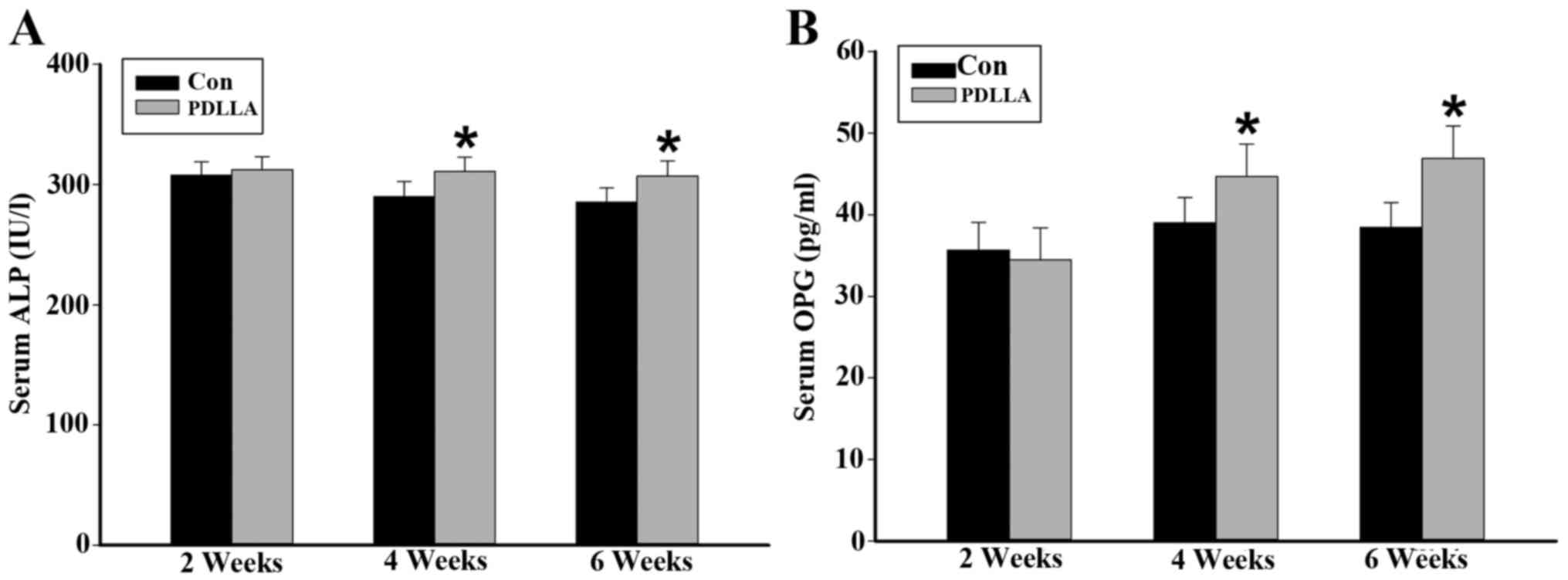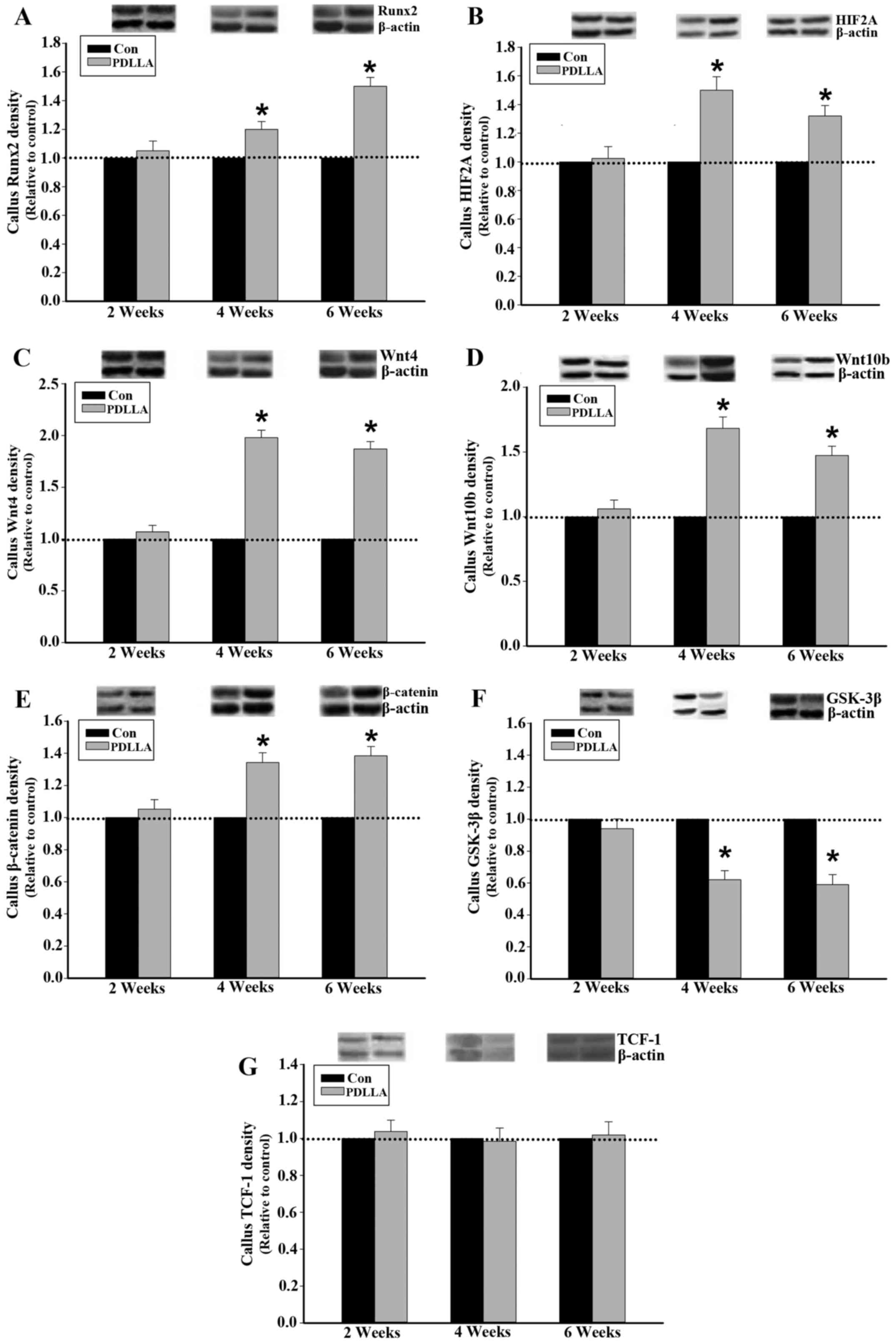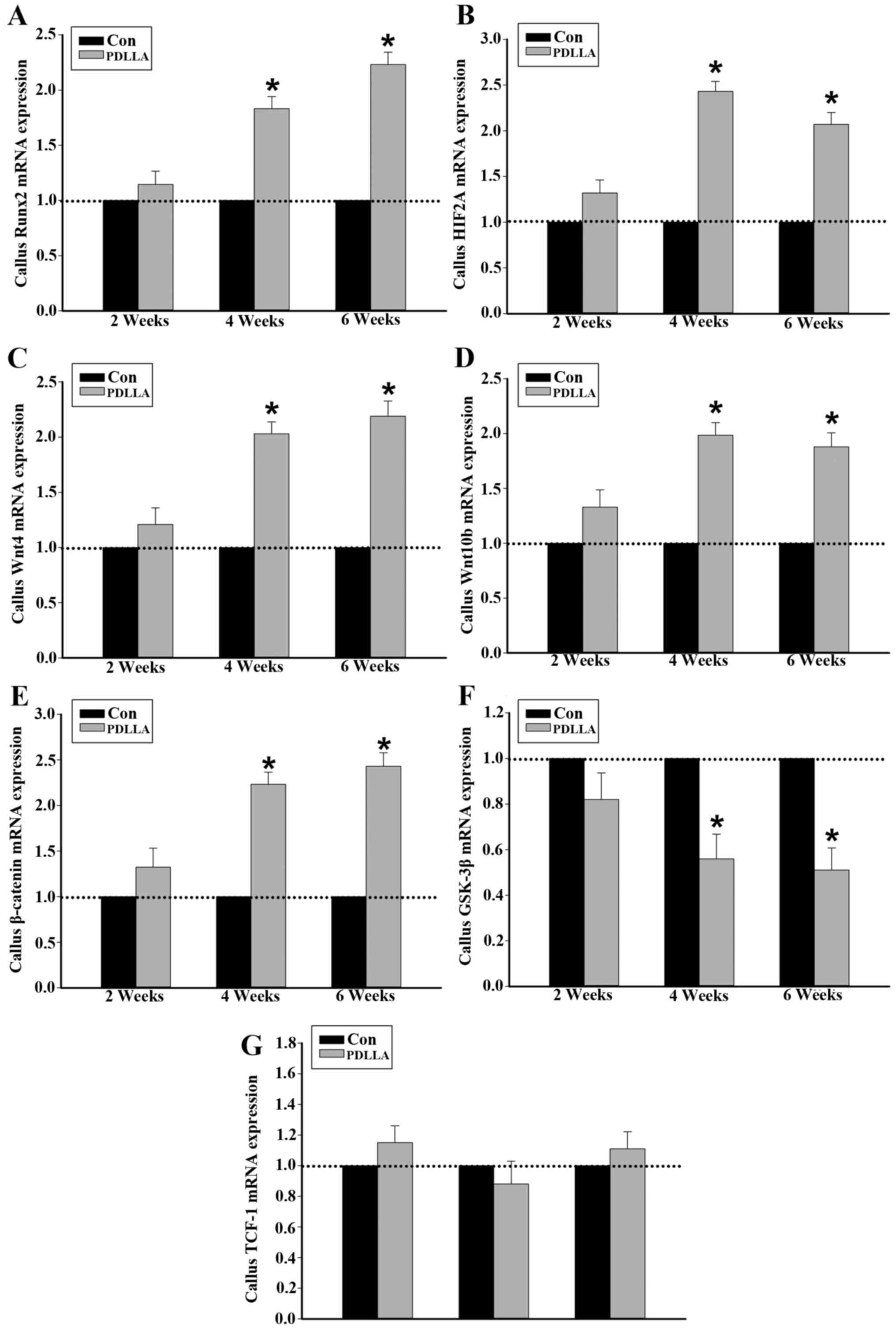|
1
|
Rokkanen P, Böstman O, Vainionpää S,
Vihtonen K, Törmälä P, Laiho J, Kilpikari J and Tamminmäki M:
Biodegradable implants in fracture fixation: Early results of
treatment of fractures of the ankle. Lancet. 1:1422–1424. 1985.
View Article : Google Scholar : PubMed/NCBI
|
|
2
|
Zantop T, Weimann A, Schmidtko R, Herbort
M, Raschke MJ and Petersen W: Graft laceration and pullout strength
of soft-tissue anterior cruciate ligament reconstruction: In vitro
study comparing titanium, poly-d,l-lactide, and
poly-d,l-lactide-tricalcium phosphate screws. Arthroscopy.
22:1204–1210. 2006. View Article : Google Scholar : PubMed/NCBI
|
|
3
|
Mukherjee DP and Pietrzak WS:
Bioabsorbable fixation: Scientific, technical, and clinical
concepts. J Craniofac Surg. 22:679–689. 2011. View Article : Google Scholar : PubMed/NCBI
|
|
4
|
Schrumpf MA, Lee AT and Weiland AJ:
Foreign-body reaction and osteolysis induced by an intraosseous
poly-L-lactic Acid suture anchor in the wrist: Case report. J Hand
Surg Am. 36:1769–1773. 2011. View Article : Google Scholar : PubMed/NCBI
|
|
5
|
Kim SH, Oh JH, Lee OS, Lee HR and Hargens
AR: Postoperative imaging of bioabsorbable anchors in rotator cuff
repair. Am J Sports Med. 42:552–557. 2014. View Article : Google Scholar : PubMed/NCBI
|
|
6
|
Fu D, Xiao B, Yang S and Li J: Open
reduction and bioabsorbable pin fixation for late presenting
irreducible supracondylar humeral fracture in children. Int Orthop.
35:725–730. 2011. View Article : Google Scholar : PubMed/NCBI
|
|
7
|
Waris E, Ashammakhi N, Raatikainen T,
Törmälä P, Santavirta S and Konttinen YT: Self-reinforced
bioabsorbable versus metallic fixation systems for metacarpal and
phalangeal fractures: A biomechanical study. J Hand Surg Am.
27:902–909. 2002. View Article : Google Scholar : PubMed/NCBI
|
|
8
|
Waris E, Ashammakhi N, Kaarela O,
Raatikainen T and Vasenius J: Use of bioabsorbable osteofixation
devices in the hand. J Hand Surg Br. 29:590–598. 2004. View Article : Google Scholar : PubMed/NCBI
|
|
9
|
Claes L, Recknagel S and Ignatius A:
Fracture healing under healthy and inflammatory conditions. Nat Rev
Rheumatol. 8:133–143. 2012. View Article : Google Scholar : PubMed/NCBI
|
|
10
|
Gerstenfeld LC, Cullinane DM, Barnes GL,
Graves DT and Einhorn TA: Fracture healing as a post-natal
developmental process: Molecular, spatial, and temporal aspects of
its regulation. J Cell Biochem. 88:873–884. 2003. View Article : Google Scholar : PubMed/NCBI
|
|
11
|
Rennert J, Coffman JA, Mushegian AR and
Robertson AJ: The evolution of Runx genes I. A comparative study of
sequences from phylogenetically diverse model organisms. BMC Evol
Biol. 3:42003. View Article : Google Scholar : PubMed/NCBI
|
|
12
|
Bustamante M, Nogués X, Agueda L, Jurado
S, Wesselius A, Cáceres E, Carreras R, Ciria M, Mellibovsky L,
Balcells S, et al: Promoter 2 −1025 T/C polymorphism in the RUNX2
gene is associated with femoral neck bmd in Spanish postmenopausal
women. Calcif Tissue Int. 81:327–332. 2007. View Article : Google Scholar : PubMed/NCBI
|
|
13
|
Qin X, Jiang Q, Matsuo Y, Kawane T, Komori
H, Moriishi T, Taniuchi I, Ito K, Kawai Y, Rokutanda S, et al: Cbfb
regulates bone development by stabilizing Runx family proteins. J
Bone Miner Res. 30:706–714. 2015. View Article : Google Scholar : PubMed/NCBI
|
|
14
|
Wu M, Li C, Zhu G, Wang Y, Jules J, Lu Y,
McConnell M, Wang YJ, Shao JZ, Li YP and Chen W: Deletion of
core-binding factor β (Cbfβ) in mesenchymal progenitor cells
provides new insights into Cbfβ/Runxs complex function in cartilage
and bone development. Bone. 65:49–59. 2014. View Article : Google Scholar : PubMed/NCBI
|
|
15
|
Xu H, Duan J, Ning D, Li J, Liu R, Yang R,
Jiang JX and Shang P: Role of Wnt signaling in fracture healing.
BMB Rep. 47:666–672. 2014. View Article : Google Scholar : PubMed/NCBI
|
|
16
|
Eastman Q and Grosschedl R: Regulation of
LEF-1/TCF transcription factors by Wnt and other signals. Curr Opin
Cell Biol. 11:233–240. 1999. View Article : Google Scholar : PubMed/NCBI
|
|
17
|
Zhong N, Gersch RP and Hadjiargyrou M: Wnt
signaling activation during bone regeneration and the role of
Dishevelled in chondrocyte proliferation and differentiation. Bone.
39:5–16. 2006. View Article : Google Scholar : PubMed/NCBI
|
|
18
|
Chen Y, Whetstone HC, Lin AC, Nadesan P,
Wei Q, Poon R and Alman BA: Beta-catenin signaling plays a
disparate role in different phases of fracture repair: Implications
for therapy to improve bone healing. PLoS Med. 4:e2492007.
View Article : Google Scholar : PubMed/NCBI
|
|
19
|
Gaur T, Lengner CJ, Hovhannisyan H, Bhat
RA, Bodine PV, Komm BS, Javed A, van Wijnen AJ, Stein JL, Stein GS
and Lian JB: Canonical WNT signaling promotes osteogenesis by
directly stimulating Runx2 gene expression. J Biol Chem.
280:33132–33140. 2005. View Article : Google Scholar : PubMed/NCBI
|
|
20
|
Rosier RN, O'Keefe RJ and Hicks DG: The
potential role of transforming growth factor beta in fracture
healing. Clin Orthop Relat Res. (Suppl 355). S294–S300. 1998.
View Article : Google Scholar : PubMed/NCBI
|
|
21
|
Livak KJ and Schmittgen TD: Analysis of
relative gene expression data using real-time quantitative PCR and
the 2(−Delta Delta C(T)) Method. Methods. 25:402–408. 2001.
View Article : Google Scholar : PubMed/NCBI
|
|
22
|
Mabilleau G, Mieczkowska A, Libouban H,
Simon Y, Audran M and Chappard D: Comparison between quantitative
X-ray imaging, dual energy X-ray absorptiometry and microCT in the
assessment of bone mineral density in disuse-induced bone loss. J
Musculoskelet Neuronal Interact. 15:42–52. 2015.PubMed/NCBI
|
|
23
|
Yonden Z, Aydin M, Alcin E, Kelestemur MH,
Kutlu S and Yilmaz B: Effects of letrozole on bone biomarkers and
femur fracture in female rats. J Physiol Biochem. 65:267–275. 2009.
View Article : Google Scholar : PubMed/NCBI
|
|
24
|
Fahrleitner-Pammer A, Dobnig H,
Piswanger-Soelkner C, Bonelli C, Dimai HP, Leb G and
Obermayer-Pietsch B: Osteoprotegerin serum levels in women:
Correlation with age, bone mass, bone turnover and fracture status.
Wien Klin Wochenschr. 115:291–297. 2003. View Article : Google Scholar : PubMed/NCBI
|
|
25
|
Yee CS, Xie L, Hatsell S, Hum N, Murugesh
D, Economides AN, Loots GG and Collette NM: Sclerostin antibody
treatment improves fracture outcomes in a Type I diabetic mouse
model. Bone. 82:122–134. 2016. View Article : Google Scholar : PubMed/NCBI
|
|
26
|
Komori T, Yagi H, Nomura S, Yamaguchi A,
Sasaki K, Deguchi K, Shimizu Y, Bronson RT, Gao YH, Inada M, et al:
Targeted disruption of Cbfa1 results in a complete lack of bone
formation owing to maturational arrest of osteoblasts. Cell.
89:755–764. 1997. View Article : Google Scholar : PubMed/NCBI
|
|
27
|
Inada M, Yasui T, Nomura S, Miyake S,
Deguchi K, Himeno M, Sato M, Yamagiwa H, Kimura T, Yasui N, et al:
Maturational disturbance of chondrocytes in Cbfa1-deficient mice.
Dev Dyn. 214:279–290. 1999. View Article : Google Scholar : PubMed/NCBI
|
|
28
|
Ueta C, Iwamoto M, Kanatani N, Yoshida C,
Liu Y, Enomoto-Iwamoto M, Ohmori T, Enomoto H, Nakata K, Takada K,
et al: Skeletal malformations caused by overexpression of Cbfa1 or
its dominant negative form in chondrocytes. J Cell Biol.
153:87–100. 2001. View Article : Google Scholar : PubMed/NCBI
|
|
29
|
Zhang Y, Hassan MQ, Montecino M, Hawse JR,
Spelsberg TC, Stein JL, Lian JB, van Wijnen AJ and Stein GS:
Synergistic regulation of the Runx2 P1 promoter in mesenchymal
cells by a conserved HLH box and purine-rich elements (GAY motifs).
FASEB J. 22:(Suppl 1). S782.7172008.
|
|
30
|
Doecke JD, Day CJ, Stephens AS, Carter SL,
van Daal A, Kotowicz MA, Nicholson GC and Morrison NA: Association
of functionally different RUNX2 P2 promoter alleles with BMD. J
Bone Miner Res. 21:265–273. 2006. View Article : Google Scholar : PubMed/NCBI
|
|
31
|
Harada H, Tagashira S, Fujiwara M, Ogawa
S, Katsumata T, Yamaguchi A, Komori T and Nakatsuka M: Cbfa1
isoforms exert functional differences in osteoblast
differentiation. J Biol Chem. 274:6972–6978. 1999. View Article : Google Scholar : PubMed/NCBI
|
|
32
|
Liu JC, Lengner CJ, Gaur T, Lou Y, Hussain
S, Jones MD, Borodic B, Colby JL, Steinman HA, van Wijnen AJ, et
al: Runx2 protein expression utilizes the Runx2 P1 promoter to
establish osteoprogenitor cell number for normal bone formation. J
Biol Chem. 286:30057–30070. 2011. View Article : Google Scholar : PubMed/NCBI
|
|
33
|
Tamiya H, Ikeda T, Jeong JH, Saito T, Yano
F, Jung YK, Ohba S, Kawaguchi H, Chung UI and Choi JY: Analysis of
the Runx2 promoter in osseous and non-osseous cells and
identification of HIF2A as a potent transcription activator. Gene.
416:53–60. 2008. View Article : Google Scholar : PubMed/NCBI
|
|
34
|
Hirata M, Kugimiya F, Fukai A, Saito T,
Yano F, Ikeda T, Nakamura K, Chung UI and Kawaguchi H: 060
Molecular network on the C/Ebp-Beta axis including Runx2, Mmp13,
and Hif2a controls osteoarthritis development. Osteoarthritis
Cartilage. 18:(Suppl 2). S342010. View Article : Google Scholar
|
|
35
|
Heidemann W, Jeschkeit S, Ruffieux K,
Fischer JH, Wagner M, Krüger G, Wintermantel E and Gerlach KL:
Degradation of poly (D,L)lactide implants with or without addition
of calciumphosphates in vivo. Biomaterials. 22:2371–2381. 2001.
View Article : Google Scholar : PubMed/NCBI
|
|
36
|
Jansen J, Koopmans SA, Los LI, van der
Worp RJ, Podt JG, Hooymans JM, Feijen J and Grijpma DW: Intraocular
degradation behavior of crosslinked and linear poly(trimethylene
carbonate) and poly(D,L-lactic acid). Biomaterials. 32:4994–5002.
2011. View Article : Google Scholar : PubMed/NCBI
|
|
37
|
Carroll SH and Ravid K: Differentiation of
mesenchymal stem cells to osteoblasts and chondrocytes: A focus on
adenosine receptors. Expert Rev Mol Med. 15:e12013. View Article : Google Scholar : PubMed/NCBI
|
|
38
|
Kim JH, Liu X, Wang J, Chen X, Zhang H,
Kim SH, Cui J, Li R, Zhang W, Kong Y, et al: Wnt signaling in bone
formation and its therapeutic potential for bone diseases. Ther Adv
Musculoskelet Dis. 5:13–31. 2013. View Article : Google Scholar : PubMed/NCBI
|
|
39
|
Monroe DG, McGee-Lawrence ME, Oursler MJ
and Westendorf JJ: Update on Wnt signaling in bone cell biology and
bone disease. Gene. 492:1–18. 2012. View Article : Google Scholar : PubMed/NCBI
|
|
40
|
Simon JA, Ricci JL and Di Cesare PE:
Bioresorbable fracture fixation in orthopedics: A comprehensive
review. Part I. Basic science and preclinical studies. Am J Orthop
(Belle Mead NJ). 26:665–671. 1997.PubMed/NCBI
|

















